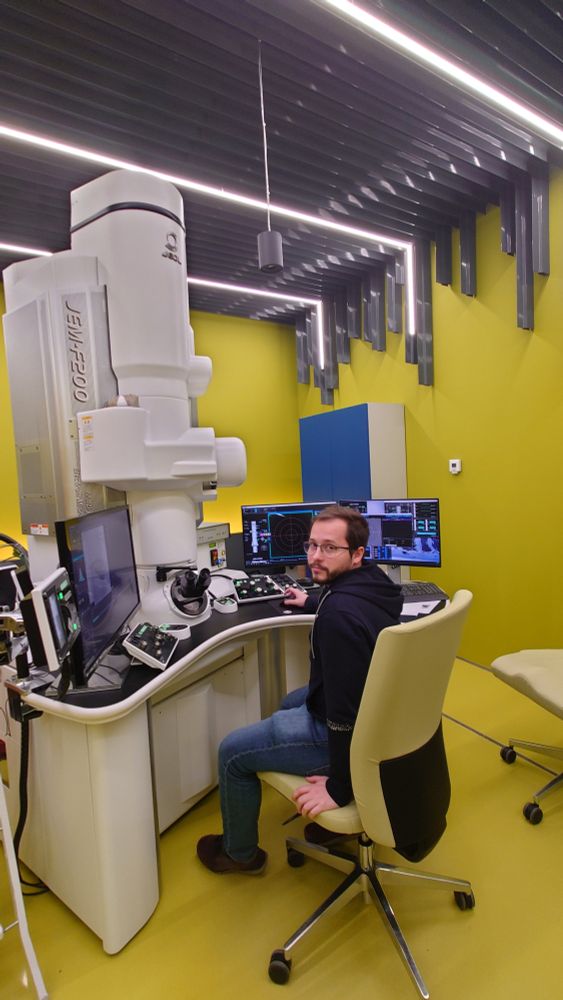

In our new paper, we use structures, MD and kinetics to show that metformin inhibits by a distinct mechanism that more hydrophobic, less well tolerated, biguanides.
www.nature.com/articles/s41...

Rare microbial relict sheds light on an ancient eukaryotic supergroup www.nature.com/articles/s41...
#Protists #Microbes #Evolution #Eukaryotes #TreeOfLife

Rare microbial relict sheds light on an ancient eukaryotic supergroup www.nature.com/articles/s41...
#Protists #Microbes #Evolution #Eukaryotes #TreeOfLife
www.nature.com/articles/s41...

www.nature.com/articles/s41...
We solved the cryoEM structure of the T7SSb core unit (T7bCU) composed of YukB, YukC, and YukD from Bacillus subtilis, revealing how these components assemble within the secretion machinery.
www.science.org/doi/10.1126/...

We solved the cryoEM structure of the T7SSb core unit (T7bCU) composed of YukB, YukC, and YukD from Bacillus subtilis, revealing how these components assemble within the secretion machinery.
www.science.org/doi/10.1126/...
Learn more in a new #SciencePerspective: https://scim.ag/4r7SLqm

Learn more in a new #SciencePerspective: https://scim.ag/4r7SLqm
www.nature.com/articles/s41...




www.nature.com/articles/s41...
www.biorxiv.org/content/10.1...

www.biorxiv.org/content/10.1...
A bile acid-bound structure of toxin TcdB revealed the mechanism of inhibition and guided the design of a synthetic bile acid that alleviated C. difficile infection in mice.
#MicroSky 🦠💊
www.nature.com/articles/s41...

A bile acid-bound structure of toxin TcdB revealed the mechanism of inhibition and guided the design of a synthetic bile acid that alleviated C. difficile infection in mice.
#MicroSky 🦠💊
www.nature.com/articles/s41...
www.nature.com/articles/s41...

www.nature.com/articles/s41...
Lab all-star @mmedina300kv.bsky.social maps these microdomains using cryo-ET + surface morphometrics.
s/o to #teamtomo #cryoET co-authors
@hamid13r.bsky.social
@attychang.bsky.social
@baradlab.com
Lab all-star @mmedina300kv.bsky.social maps these microdomains using cryo-ET + surface morphometrics.
s/o to #teamtomo #cryoET co-authors
@hamid13r.bsky.social
@attychang.bsky.social
@baradlab.com
Or from a single dish of HEK cell culture in the case of two membrane proteins.
Out in Nature Methods now! lnkd.in/gpyBSceg
Wonderful collaboration with the Efremov lab.

Or from a single dish of HEK cell culture in the case of two membrane proteins.
Out in Nature Methods now! lnkd.in/gpyBSceg
Wonderful collaboration with the Efremov lab.
Link seemed broken though so here's a working one:
www.pnas.org/doi/10.1073/...

Link seemed broken though so here's a working one:
www.pnas.org/doi/10.1073/...
www.biorxiv.org/content/10.1...


www.biorxiv.org/content/10.1...
In our new paper, we use structures, MD and kinetics to show that metformin inhibits by a distinct mechanism that more hydrophobic, less well tolerated, biguanides.
www.nature.com/articles/s41...

In our new paper, we use structures, MD and kinetics to show that metformin inhibits by a distinct mechanism that more hydrophobic, less well tolerated, biguanides.
www.nature.com/articles/s41...
www.nature.com/articles/d41...

www.nature.com/articles/d41...
www.science.org/doi/10.1126/...
@unmc.bsky.social @uwbiochem.bsky.social

www.science.org/doi/10.1126/...
@unmc.bsky.social @uwbiochem.bsky.social
In our new paper, we use structures, MD and kinetics to show that metformin inhibits by a distinct mechanism that more hydrophobic, less well tolerated, biguanides.
www.nature.com/articles/s41...

In our new paper, we use structures, MD and kinetics to show that metformin inhibits by a distinct mechanism that more hydrophobic, less well tolerated, biguanides.
www.nature.com/articles/s41...
Brilliant study led by @fmacleod.bsky.social and Andriko von Kügelgen. Tight collaboration with @buzzbaum.bsky.social and lab. Congrats to all authors!
www.biorxiv.org/content/10.1...

Brilliant study led by @fmacleod.bsky.social and Andriko von Kügelgen. Tight collaboration with @buzzbaum.bsky.social and lab. Congrats to all authors!
www.biorxiv.org/content/10.1...

Fantastic training opportunity for anyone working with genomic data and evolutionary questions.
Highly recommended - amazing course, great community, and a fantastic setting!

Fantastic training opportunity for anyone working with genomic data and evolutionary questions.
Highly recommended - amazing course, great community, and a fantastic setting!
@zestytoast.bsky.social tagged a scarce mycobacterial protein in M. smegmatis with TwinStep but got… something? @kjamali.bsky.social's ModelAngelo built models & @martinsteinegger.bsky.social's FoldSeek IDed them as the biotin-containing MCC & LCC complexes
🧵
tinyurl.com/ukny4ptz

@zestytoast.bsky.social tagged a scarce mycobacterial protein in M. smegmatis with TwinStep but got… something? @kjamali.bsky.social's ModelAngelo built models & @martinsteinegger.bsky.social's FoldSeek IDed them as the biotin-containing MCC & LCC complexes
🧵
tinyurl.com/ukny4ptz
More here: https://bit.ly/3LbHTaF
More here: https://bit.ly/3LbHTaF

